Remembering the Past
As the final day of the month of January, today marks the last day of Howard Permut’s tenure as president of Metro-North Railroad. While 2013 was set to be a celebrated year – with Metro-North’s 30th anniversary, and the centennial of Grand Central Terminal – instead the year was tainted with mishaps and tragedies. You can say what you wish about Mr. Permut’s years as president, but it remains fact that he was a member of the team that formed the railroad 31 years ago. His insider’s perspective on Metro-North, and how it evolved over the years, made an interesting interview.
In a time where countless commuters wish to revolt, some going as far as to say Metro-North is the “worst railroad” ever or like a “horror movie,” I come with an idea many will outright refuse to accept. It is, however, the truth. Metro-North has in fact evolved over the past 31 years. I hardly believe it is deserving of the “worst railroad ever” superlative that some are attributing to it, but such a description may be apt for one of Metro-North’s predecessors.
I’m a firm believer in the adage that those who do not remember the past are doomed to repeat it. History is incredibly important, and it has been painfully obvious recently that many are deficient in that area – especially when it comes to trains. It is undeniable that Metro-North has had some major issues within the past twelve months, and there are many lessons the railroad must learn. But we must know the past to adequately move into the future – thus if one wishes to truly understand Metro-North, a little visit to the past is required.
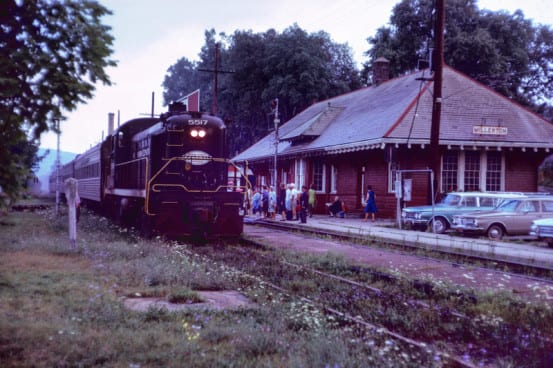
Although frolicking in a grassy meadow may be fun, for the Upper Harlem it displays neglect. Less than a decade from when this photo was taken in 1966, Millerton and the rest of the Upper Harlem was abandoned for passenger service.
We rewind the clock back to 1968 – the year of the ill-fated merger between the Pennsylvania Railroad and the New York Central (the New York, New Haven and Hartford was added to the merger in 1969). Within a scant two years the Penn Central was bankrupt – the railroad was the country’s sixth largest corporation, and at the time its bankruptcy was the largest this nation had ever seen. If you want to think of a horrible American railroad, this is where you should start – besides incompatible computer systems and clashing employees, deteriorating infrastructure led to slow and late trains, and entire freight trains went missing – crops destined for the market rotted, and with 25% on-time performance for some deliveries, companies left to find other methods to ship goods.
One of the reasons this site even exists is because of my interest in Penn Central’s abandonment of the Upper Harlem Division. On a cold March morning in 1972 the 6:55 train from Chatham to Grand Central operated as normal. However, by midday the Penn Central legally won the right to terminate the line, and fifty miles of the Upper Harlem Division were abandoned for passenger service. Anyone that came down on that morning train had no ride home – they had to find their own way. Imagine how angry people would be if Metro-North tried to pull the same stunt today! Sorry, New Haven commuters, our last stop today, and forevermore is Port Chester, and we don’t care how you get home.
The Evolution
Penn Central operated after bankruptcy for a few more years, until its operations were taken over by other companies. Conrail became the steward of Grand Central’s commuter lines until Metro-North was formed and took over operations in 1983. Metro-North Day One was hardly anything to rave about. This is what you’d find at Putnam Junction, aka Brewster Yard:
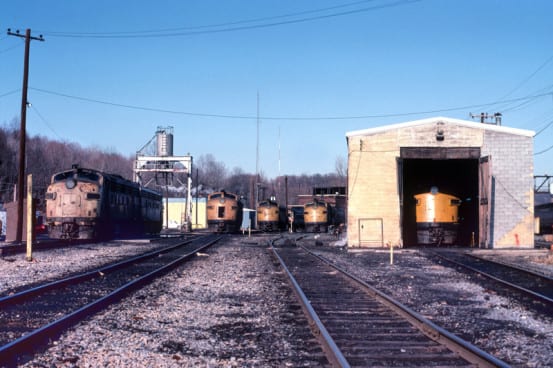
Mind you, this is what it looks like today:
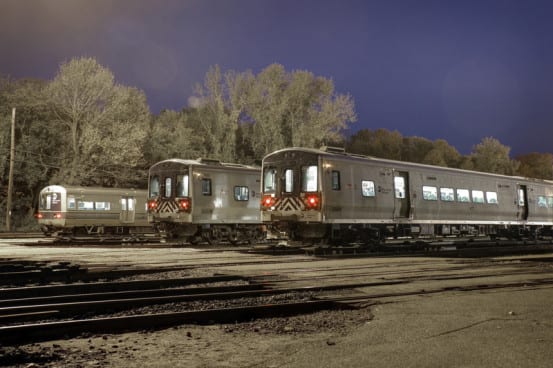
In the earliest days, it was obvious that Metro-North was cobbled together from the remains of the New York Central, New York, New Haven and Hartford, Penn Central, and Conrail. Here’s a shot from 1984 in Poughkeepsie:
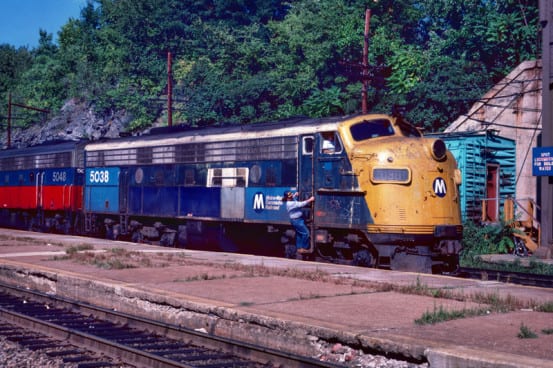

Equipment you'll see today on Metro-North
Besides the obvious update of rolling stock (and you Connecticut folks can go pin your miseries in that department on disgraced former Governor John Rowland – perhaps if he cared for commuters as much as he did his weekend home you’d be a bit less miserable), Metro-North has significantly upgraded its shops to accommodate repairs and maintenance of the new equipment. The old New York Central shops at Croton-Harmon dated back to 1909, and were restored in Metro-North’s earliest years. In 2010 they were reconstructed, and the new Croton-Harmon Locomotive and Coach Shop is now a modern, state-of-the-art facility. A new shop at Brewster opened in 1987, and at North White Plains in 1993.
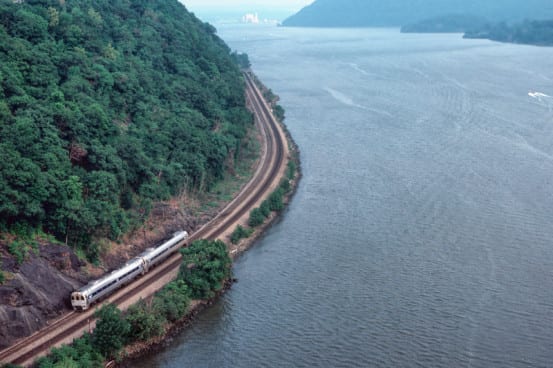
SPV2000 on the Upper Hudson Line in 1985. These days both the Upper Hudson Line and Upper Harlem Line get enough traffic that there are 7-car through trains a few times per day. In 1983 only eight southbound trains operated on the Upper Harlem, today thirteen trains depart Wassaic every day, bound for New York City.
Most of Metro-North’s stations look quite different than in the past, as almost every station now has high-level platforms. New York Central engineers working on the design of Grand Central Terminal in the early 1900s clocked patrons boarding trains and calculated that riders board 50% faster on high level platforms. They also make it easier to accommodate those with baby carriages, and patrons in wheelchairs. Despite the pros of high level platforms, they were not implemented system-wide until after Metro-North took over. On average, the duration of a trip from Grand Central to Dover Plains in 1972 was about two hours and 20 minutes – today the trip takes about two hours, and note that the route is six miles longer and terminates at Wassaic. Faster boarding allows for quicker train times.
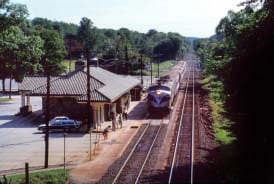
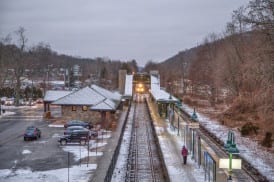
High level platforms, overpasses and elevators are just some of the changes seen here at Chappaqua. Compare 1982 to today.
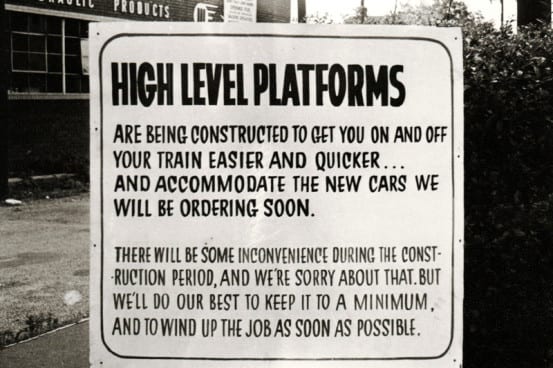
Before Metro-North took over, you may have seen a sign like this…
One of the most influential changes made by Metro-North was the electrification of the Harlem Line north of White Plains. Service up to Brewster became incredibly more reliable, and led to an increase in ridership. When constructed early on, Brewster North (now Southeast) was often empty – now you’ll see an immense filled parking lot with riders from both New York and Connecticut. Despite out-of-touch politicians arguing that people are packing up and leaving the area because of poor train service, or at minimum opting to drive, ridership – even on the beleaguered New Haven Line – actually increased.
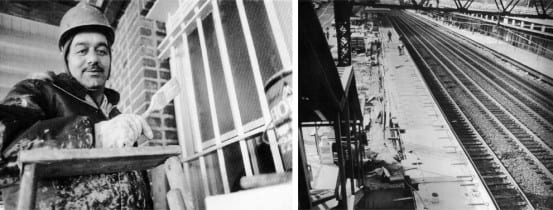
Restoration of Ossining station, on the Hudson Line, and platform upgrades at Larchmont on the New Haven Line. Photos from the collection of Metro-North Railroad.
As a lover of history, the fact that many historic train depots have been restored during Metro-North’s tenure is an important point. Grand Central, Harlem 125th Street, New Haven Union Station, Port Chester, Chappaqua, Hartsdale, Yonkers, Ossining… the list could go on. It is also worth mentioning that restoration work was also performed on the Park Avenue Tunnel. I appreciate the efforts of the railroad, of the communities, and of the state to preserve our history.
Metro-North has also opened several stations over the years, on all three lines. The Harlem Line was lengthened to Wassaic, the Yankees E 153rd Street stop makes it easier for people to get to the baseball game, and two different Veterans Hospitals are accessible from Cortlandt and West Haven stations. Even the famed Appalachian Trail now has a train station along the Harlem Line.
Looking to the Future
No railroad wants to have late trains, but unfortunately it has become a fact of life for Metro-North. After the derailment at Spuyten Duyvil speed restrictions can be found on all Metro-North lines (especially the New Haven Line). Perhaps in the past there were safe spots that engineers could “make up time,” but they are no more. However, it is incredibly irresponsible to pretend that all methods of transit are at a hundred percent, all the time. Everyone always has the option to drive, and maybe you’ll even get there on time – provided that I-95 isn’t shut down because of an overturned truck, that the Saw Mill isn’t closed because of flooding every time we get a good rainstorm, or the Taconic is closed for construction. Plus we all know that nobody ever sleeps in airports because flights are delayed for days, and that multi-car pileups are pure fiction.
No commuter wants to ride a late train, but make some friends, try to enjoy your ride home. There are very few times that the train has gotten me to work seriously late, but I can count plenty of times that driving coworkers have been late due to traffic, construction, or other accidents. Take it from 50 year Harlem Line commuter John F.:
In 1964, I started riding the New York Central train from Bronxville to Fordham University in the Bronx every day. I have enjoyed commuting via the Harlem Line most years ever since. Perhaps the best part has been and continues to be the friends I have made on the train over the years with conductors and fellow passengers. I’ve been fortunate enough to meet some fascinating people who have enriched my life. My goal is to continue commuting and making friends until 2026.
Fifty years ago, commuting was an opportunity to relax, play cards and chat with friends you saw everyday. When we all get bored with our laptops and cell phones, I hope that the opportunity to engage in good conversation with conductors and fellow commuters is still there.
In closing, Metro-North has much potential for greatness, and we wholeheartedly welcome the very well respected railroader Mr. Joseph Giulietti in his position as president of this railroad (effective February 10th). Similar to Mr. Permut, Mr. Giulietti was around for the fledgling Metro-North Commuter Railroad’s earliest days. He understands the past, and undoubtedly has aspirations for a bright future. I will be happy to see this railroad further evolve, and hey, Mr. G? Want to do an interview? Come talk to me!


Great article.
My husband and I lived up in Dutchess County back in the late 1980s and have lived in Westchester County since 1994. During that time, it is amazing how much better the service has gotten and how much better the stations look. I really do think that you have to be a long time rider to appreciate it.
Yeah, 2013 was a pretty awful year and we certainly hope that is not a trend but it really is hard to argue against the facts that the Metro-North line is a vital chain in the region’s economy.
One thing you left out is the rise of reverse commutation that has actually fed the suburbs. There is now a small but vital economy that has grown up over the past ten years to shuttle NYC people from the stations in Hawthorne-Valhalla-White Plains to jobs in Westchester.
You’re totally right about the reverse commutation thing. I work in Valhalla, actually. The company sends a bus to pick us all up at White Plains, and I have quite a few coworkers that come in from the city.
Anyone who thinks Metro-North is “the worst railroad ever” has clearly never been subjected to the tender mercies of SouthEastern, the commuter rail network serving SE London and Kent in the UK. I have, and Metro-North is commuter heaven in comparison.
2014 will be 25 years riding the Harlem for me. Passing through Grand Central every day is a highlight for me. There have been a few bumps in the recent past but Metro North and it’s personnel generally do a difficult job very well year in and year out. Thanks to all.
Great article Emily!
You got it right
I like your site as one who worked for Conrail and MNRR 34 years in the track dept. Keep up the good work
Thank You Emily for posting this. It was really wonderful reading your article and all the folks comments really made my day and lifted my sprits…..
Great story! You’re right, when I started in ’86, Metro North was new and everything else was old. It was like the land that time forgot. This kind of puts it in perspective.
Great job, Emily! Your website is certainly one of the coolest railroad websites I’ve found. I recognized you immediately when we first sat opposite each other — you in the foldown seat and me in the conductor’s cab — but I never took the time to congratulate you on the quality (and accuracy) of your site. I retired last year, so chances are I won’t get the opportunity again, but I’d like to add myself to your fan club! Keep on keeping on!
Wonderful piece, Emily. Penn Central is my morbid railroad interest of choice, although I’m barely old enough to remember Conrail, let alone PC.
History aside, you’re spot on with your comparisons of trains to other modes of transportation. I stopped letting late trains bother me a long time ago!
Service quality was poor on the former New York Central and New Haven railroads even prior to the Penn Central merger. Those companies were losing a great deal of money on commuter service and had nothing to invest to make repairs.
Veteran commuters can remember diesel trains operating all the way into Grand Central, with their exhaust fumes wafting through the concourse. Also, a motley of collection of old cars were acquired from other railroads to keep service running.
Grand Central Terminal itself was very run down.
The New Haven line depended on the ancient Cos Cob power plant, which was very unreliable.
So, the MTA did indeed do a remarkable job reversing all the decay (as it also did on the Long Island Rail Road).
As to the speed restrictions in the wake of the Spuyten Duyvil accident, I hope that only those that are truly needed for safety remain in place, and others, perhaps not really needed, can be removed.
People Downstate really have no clue, they should try arriving at the station 30 mins early for a train that is 5 hours late, because Amtrak didn’t update the train status. Or get stuck on the Thruway 2 miles from home, in a total whiteout of a blizzard for 6-8 hours, with little gas! (because someone had the brilliant idea to send some of our road crews to LI instead)
MNCR has a severe “good buddies” culture problem (and most of the MTA does too), and until most of the upper management is replaced, or put in their place, nothing is going to change. Getting a new president is a good first step.
Any time FRA has to step in just to have proper track inspections performed, or issue an EO to keep engineers focused and prevent speeding, it is a clear sign that the RR hasn’t yet grasped their responsibilities towards their patrons. Looking at the inspection report from the FRA conducted (in May) by the geometry car shows that the problems were more serious than anyone knew, including some sections of track that came up 0 track class (excepted) over which it is ILLEGAL to move occupied trains. The speed restrictions following the SD incident were expected, just a way for MNCR to avoid spending more money making changes to the signal system (as required by the EO) before PTC installation BY 2015 (which we all know isn’t going to happen).
All in all it is not good enough to say “we’re better than everyone else” or “it aint as bad as it used to be”, it is far more necessary to focus on working towards being better than things are now (and to fully comply with all federal regulations, of course)!
I began my railroad career on Metro North in Grand Central Terminal or as we affectionately called it “GCT”. When I started CTC was still in along with towers A/B/C & U in the terminal. Still in operational were Nick on the Park Ave. viaduct, MO in Mott Haven, DV at Spuyten Duyvil. As far as memory serves towers in Stamford were still manned and the draw bridges along the New Haven Line. The RTC center in GCT was still transforming. One of the biggest projects I worked on was the moving of the signal wires under the 138th street drawbridge as Conrail’s new route to Oak Point was being built and Metro North Highbridge yard was nothing but an over grown weed field.
I also worked on the the concrete tie project along the Harlem Division back in the early 1990’s. One morning at Woodlawn the RTC called and he lost control of the interlocking and had requested us to take it on local control. Meaning we would be on the phone with the dispatcher and we would line the routes on the CTC board inside the “CIL” boxes. Simple right, no that failed also so “Plan C” was formed and we had to spend the morning rush hand cranking 85ft super switches via radio with GCT. PX90 has nothing on that!
I used to ride the Harlem line in 1969/70 while a student at the Linden Hill School,administered,by the Jewish board of Family and Children services,the school is located in the verdent hills of beautiful Hawthorne,NY,in Westchester,it is also chartered by the NY Board of regents,they set the standards of grades for students to attend these prepatory schools,Linden Hill is both a boarding school,and a day school for residents of westchester county.They do their best to help the students reach their full potential.What ever problems the students have,they have accredited,proffessionals who are there to help.and also the school is accessable by Metro-North train,Harlem line station at,Hawthorne,N.Thanks.
With all this talk about how much better Metro-North is than back in the days of the run-down New York Central, Penn Central, and New Haven Railroads, would it be in bad taste to remind people that I’d like to see some locomotives on the Harlem and Hudson lines painted up like old NYC locomotives, just like the ones on the New Haven Line, are painted up like old New York, New Haven & Hartford locomotives?